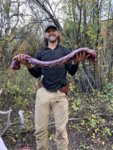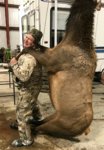the_bowhunter
Lil-Rokslider
- Joined
- Jan 10, 2015
- Messages
- 164
For context, I worked for an outfitter in NW Colorado in September.
We probably had a 50/50 split on hunters who used fixed versus mechanical broadheads. I wanted to write a report on performance and animal recovery rate to help out anyone who was on the fence on which head to use.
This is not a post to debate which is better to use or if the shots taken by our hunters were "ethical" or not. This is a report of what happened in some real life scenarios.
In my own opinion, if there is not an exit hole on the opposite side of the animal that you are shooting at then I would consider that not ideal penetration.
My numbers may not be exact as we had a large amount of hunters and lack of sleep may have gotten the best of my memory.
Bulls lost in the field- 7 or 8 total
Elk killed in the field- 11
Mechanical broadhead findings-
A hunter never had a full pass through with a mechanical broadhead.
I had a hunter shoot a bull at 31 yards. The mechanical failed to open and was stuck in the opposite shoulder of the bull. Perfect shot placement and the bull died 80 yards from where he was hit. The same hunter had an arrow pretty much bounce off of a bull the day before as the same broadhead hit a patch of grass and opened before it hit the elk.
Our last bull shot on Sunday was with a mechanical at 55 yards. The shot was a foot back and clipped both lungs and the liver. I do believe if the hunter had not been shooting a mechanical that the bull would have not been recovered as quickly as he was. The bull ran about 100 yards and died within seconds.
We had two frontal shots on elk with hunters using mechanical with the shots being under 10 yards. Arrow path once the arrow made contact with the elk was sporadic. One of these bulls was recovered with follow up shots needed from the hunter with his bow.
Overall, I saw very poor penetration with hunters using mechanical heads.
Shots that were farther back behind the shoulder showed to have better penetration than shots that were too far forward which led to a couple bulls being lost because the mechanical head could not penetrate the shoulder blade.
Fixed broadhead findings-
I shot a cow elk at 3 yards. My shot passed through both of her shoulders and my arrow was about 20 yards past her. I pull 75 pounds and use a single bevel.
The farthest shot on an elk was at 70 yards and the elk took a couple of steps and expired. The shot placement was just inside of the shoulder and 1/3 of the way up from the belly.
Bulls that were lost while using fixed broad-heads were because of poor shot placement. We never had a fixed blade "fail" to operate.
The farthest we tracked a bull was just over 3 miles on a shot that hit the neck. This bull was never recovered as we do not believe the shot was fatal.
We had one shot that on video showed the arrow to be in almost a perfect shot placement position for a kill but we did not recover that bull. To our best guess the bull jumped the string and turned so maybe the arrow deflected off of a rib went it hit the elk. The arrow had maybe 18 inches of penetration. This one definitely puzzled us.
Most of the elk that were killed with a fixed head died within site. 100 yards or less
These are a few of my notes from 4 weeks in the field. I would personally recommend that if you are looking for an arrow for your elk hunt that you shoot a heavy grained shaft with a large fixed blade as your broadhead. Having an arrow setup for a rainy day can help keep you from heartbreak of making a good shot but having your arrow or broadhead "malfunction".

We probably had a 50/50 split on hunters who used fixed versus mechanical broadheads. I wanted to write a report on performance and animal recovery rate to help out anyone who was on the fence on which head to use.
This is not a post to debate which is better to use or if the shots taken by our hunters were "ethical" or not. This is a report of what happened in some real life scenarios.
In my own opinion, if there is not an exit hole on the opposite side of the animal that you are shooting at then I would consider that not ideal penetration.
My numbers may not be exact as we had a large amount of hunters and lack of sleep may have gotten the best of my memory.
Bulls lost in the field- 7 or 8 total
Elk killed in the field- 11
Mechanical broadhead findings-
A hunter never had a full pass through with a mechanical broadhead.
I had a hunter shoot a bull at 31 yards. The mechanical failed to open and was stuck in the opposite shoulder of the bull. Perfect shot placement and the bull died 80 yards from where he was hit. The same hunter had an arrow pretty much bounce off of a bull the day before as the same broadhead hit a patch of grass and opened before it hit the elk.
Our last bull shot on Sunday was with a mechanical at 55 yards. The shot was a foot back and clipped both lungs and the liver. I do believe if the hunter had not been shooting a mechanical that the bull would have not been recovered as quickly as he was. The bull ran about 100 yards and died within seconds.
We had two frontal shots on elk with hunters using mechanical with the shots being under 10 yards. Arrow path once the arrow made contact with the elk was sporadic. One of these bulls was recovered with follow up shots needed from the hunter with his bow.
Overall, I saw very poor penetration with hunters using mechanical heads.
Shots that were farther back behind the shoulder showed to have better penetration than shots that were too far forward which led to a couple bulls being lost because the mechanical head could not penetrate the shoulder blade.
Fixed broadhead findings-
I shot a cow elk at 3 yards. My shot passed through both of her shoulders and my arrow was about 20 yards past her. I pull 75 pounds and use a single bevel.
The farthest shot on an elk was at 70 yards and the elk took a couple of steps and expired. The shot placement was just inside of the shoulder and 1/3 of the way up from the belly.
Bulls that were lost while using fixed broad-heads were because of poor shot placement. We never had a fixed blade "fail" to operate.
The farthest we tracked a bull was just over 3 miles on a shot that hit the neck. This bull was never recovered as we do not believe the shot was fatal.
We had one shot that on video showed the arrow to be in almost a perfect shot placement position for a kill but we did not recover that bull. To our best guess the bull jumped the string and turned so maybe the arrow deflected off of a rib went it hit the elk. The arrow had maybe 18 inches of penetration. This one definitely puzzled us.
Most of the elk that were killed with a fixed head died within site. 100 yards or less
These are a few of my notes from 4 weeks in the field. I would personally recommend that if you are looking for an arrow for your elk hunt that you shoot a heavy grained shaft with a large fixed blade as your broadhead. Having an arrow setup for a rainy day can help keep you from heartbreak of making a good shot but having your arrow or broadhead "malfunction".


